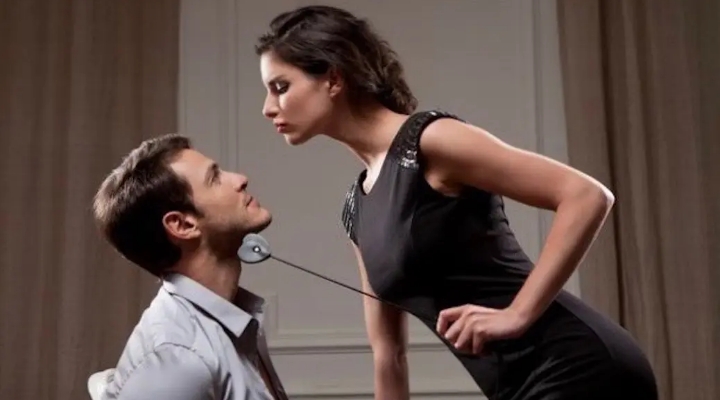Topping from the Bottom: What Does Topping from the Bottom Mean?

What does “Topping from the Bottom” mean? Ever since the book 50 Shades of Grey made the expression popular, the meaning and actual definition have become cloudy. In BDSM, the definition of “Topping from the Bottom” (or TFTB) is when a submissive starts to become more of the dominant in the relationship. I’m going to show you three examples of topping from the bottom and what both the Dom and sub can do to fix it.

What is Topping from the Bottom in a BDSM Relationship?
The expression, Topping from the bottom, sometimes happens subconsciously, but it can also be done on purpose. It’s a lot like using reverse psychology and can turn the tables of control without the Dominant realizing it.
Usually, the submissive is the most to blame for this manipulation, but the Dom is equally at fault when they allow it to happen. I admit that I have topped from the bottom before, and it can be a hard habit to break in a relationship.

Examples of Topping From the Bottom in Real Life BDSM (not the book, 50 Shades of Grey):
While the book 50 Shades of Grey may have made the expression a flirtatious cliche, topping from the bottom can actually cause serious problems in a relationship. Here are three potential issues to watch out for:
Example of Topping from the Bottom #1: Being a Constant Brat on Purpose
Some Doms like the challenge of having their sub a little bratty every once in a while. (the definition of a brat is a naughty, playfully disobedient sub). There’s nothing wrong with brats or bratty behavior. It can keep things fun and interesting. Where topping from the bottom in this manner becomes a problem is when a sub is unceasingly a brat, often using the behavior to lash out.
Instead of a way to be more playful, it becomes the main way to receive attention and get what they need. Needless to say, it can irritate the Dom and make them want to give up.
What The submissive Can Do:
If you genuinely want more attention or feel that your needs aren’t getting met, speak up instead of topping from the bottom! As long as it’s done respectfully, there is nothing wrong with communicating what you want.
For example, I’ve acted out before after a hard day just to get in trouble. I know this will get me that stress-relieving spanking I so desperately need. I’ve learned, though, that it’s so much better to say, “Daddy, I’ve had a hard day. Can you please spank me?”
It makes him happy and so much more aware of my feelings. And the next time he sees me stressed, he knows exactly what I need.
If you’re not comfortable speaking up, you can also write your feelings in a submissive journal (either online or in a book) that your Dom can read.
What The Dom Can Do:
When you catch your sub being bratty, or topping from the bottom, try to figure out if they’re just acting out for attention. Remember: this isn’t 50 Shades of Grey, so instead of just immediately turning to discipline, ask your sub what’s really going on. If you sense they’re upset, give them permission to talk.
Encourage them to maybe use an “I statement.” The definition of an “I statement” is a phrase where they say, “I feel X when you do Y, and I’d rather you do Z.” Also, having your sub kneel while you talk to them about their unacceptable bratty behavior can put them back in their place.

Example of Topping from the Bottom #2: Safewording… without really meaning it
Let me start off by saying that there is nothing wrong with using safewords. They are a sacred part of BDSM, and are there to make sure everything stays safe, sane, and consensual. The definition of a safeword is a word or phrase that a sub (or Dom) uses when they are close to or at their limit. A sub should never feel guilty when they use them legitimately.
The problem arises when it becomes a way to get out of something they just don’t want to do. It can become the vanilla equivalent of saying they have a headache.
Besides sexual requests, they may use a safeword when a situation becomes emotionally difficult and they just want a break. This becomes problematic topping from the bottom because the sub becomes the one in control when they safeword because they just don’t feel like doing something.
What the sub Can Do:
Before you safeword, ask yourself if you’re just trying to avoid doing something. If you were to meet your Dom’s demands, would it really incur physical, mental, emotional, spiritual, or other harm? If not, safewording, in that instance, would be dishonest and could lead to a break in trust.
Remember that topping from the bottom in this way isn’t playing fair. If there are things that you absolutely will not do, make sure to include them in a BDSM contract.
What The Dom Can Do:
If your sub safewords, remember that it means they are close to their limit of endurance, or they cannot tolerate any further demands. Always respect their safeword even if you believe it isn’t genuine. Your actions should cease completely with immediate effect.
Afterward, if you do believe the safeword was used casually, tell your sub. Remind them of the real purpose of BDSM safewords and topping from the bottom by misusing them will break your trust. This firm lecture will probably be enough to put them back in their place.

Example of Topping from the Bottom #3: Saying, “Well, actually I think…” or a similar expression
When a Dom makes a decision, it should stand. A sub, from time to time, can voice their opinion respectfully when necessary, but routinely getting a Dom to change their mind will only hurt the relationship. This can happen in many different areas.
Some examples of topping from the bottom include:
- The Dom wanting to have sex in a certain position, but the sub suggests another one instead.
- Or he wants to book reservations at a particular restaurant, but she says she’d rather go to a different one.
When these types of topping from the bottom happen, and the Dom gives in, it shifts the control in the relationship.
What The sub Can Do:
When your Dom makes a decision, don’t undermine it by topping from the bottom. Even if it’s not what you were wanting, that doesn’t matter. Your role is to please your Dom. If it’s something you really disagree with, you can let them know respectfully.
Another option is to ask them afterwards if next time you can do your choice, or voice your feelings in a journal book. Remember: this isn’t 50 Shades of Grey. You are in a real BDSM relationship, and they are your Dominant. Topping from the bottom will only erode that.
What the Dom Can Do:
When your sub says, “Well, actually I think…” or a similar expression, listen to their suggestion, but then let them know that you are the Dom and you make the decisions. Of course, they are not always going to act perfectly or by the book, but tell them that this behavior is below your standards.
When they do go along with what you want, make sure to give them praise. It is OK to give your sub choices every once in a while, but do not make it a habit of yielding to them.
*If you want to motivate your partner to be more dominant, submissive, or kinky without nagging or topping from the bottom, be sure to check out my new BDSM partner workshop.*

Frequently Asked Questions About Topping from the Bottom
What are the potential problems with “topping from the bottom”?
Topping from the bottom can lead to issues within a BDSM relationship, such as a breakdown in trust or a feeling of manipulation on the part of the dominant partner. It might hinder the genuine power exchange and inhibit the dominant partner from fully embracing their role. Resentment or frustration could build up over time if one partner feels their desires or needs are not being met due to constant manipulation.
Can “topping from the bottom” be consensual?
Yes, “topping from the bottom” can be consensual if both partners agree to engage in this type of power exchange. Some individuals may enjoy elements of topping from the bottom as part of their BDSM dynamic as long as there is open communication, trust, and mutual consent between all parties involved.
How can one prevent “topping from the bottom” in a BDSM relationship?
Clear and open communication is essential in BDSM relationships to prevent misunderstandings and ensure that both partners are on the same page. Setting boundaries, discussing roles and expectations, and establishing a safe word are important steps in maintaining a healthy BDSM dynamic. Regularly checking in with each other about the relationship’s progress can also help address any potential issues.
Balancing Trust and Control: Understanding the Implications of Topping from the Bottom in BDSM Relationships
Remember that regularly topping from the bottom brings manipulation into BDSM, and can mean there are underlying issues in the relationship. Life isn’t 50 Shades of Grey. So review the actual definition and our real-life examples of topping from the bottom, stay focused in your role as a Dom or sub, and the power and control will remain healthy in your relationship.

Want more? Sign up for my newsletter and get BDSM tips on the regular.
Related Articles

Submissive Punishments: How to Punish Your Sub Effectively
Most Dominant/submissive relationship usually have varying types of submissive punishments…

What is a Switch in Bed? The Guide to How to Be a Switch
When most people think of a BDSM relationship, they usually only think of the Dominant and submissive roles…

The Ultimate Guide to Keeping a Submissive’s Journal
In beginning my BDSM journey as a sub, I thought keeping a submissive’s journal was very vanilla…
